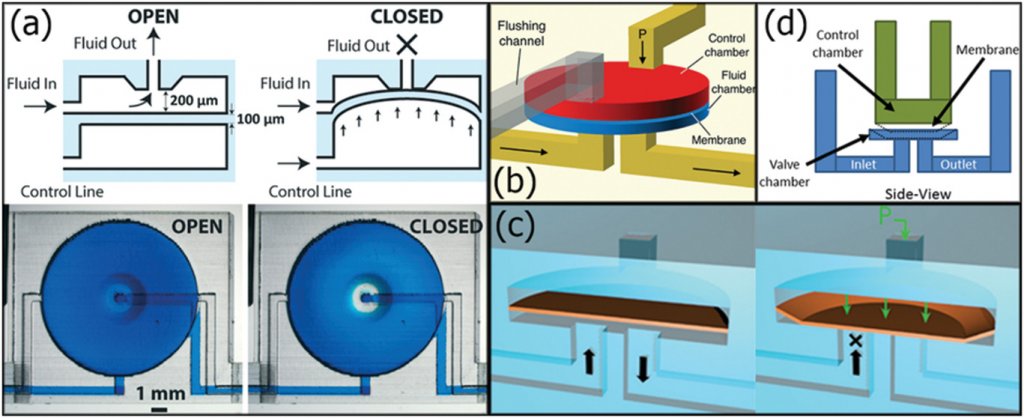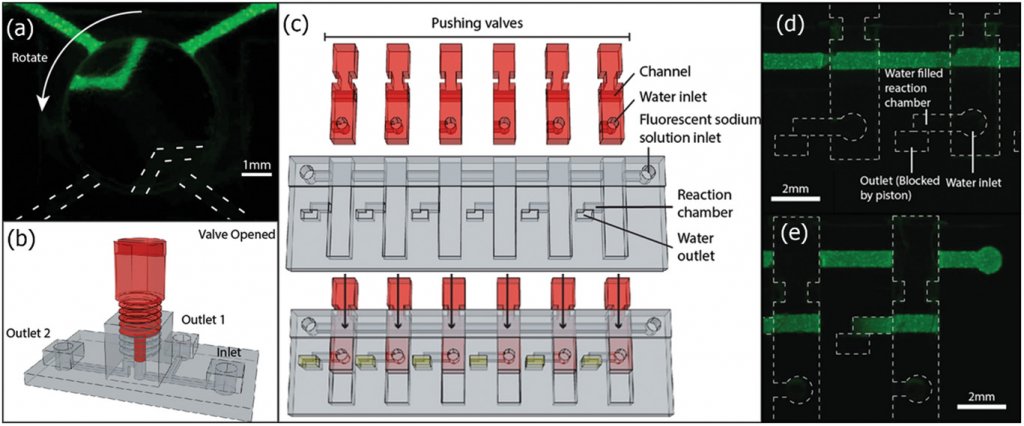Researchers present an overview of 3D printing microfluidics in the recently published ‘Functional 3D Printing for Microfluidic Chips.’ Allowing for epic ‘downscaling’ of biochemical applications—and from the lab to a portable mode, 3D printed microfluidics can be applied to many different applications from sensors and actuators to parts designed for movement like valves, pumps, or fluid flow.
Scientists predict that 3D printing in microfluidics will be the precursor to a ‘new generation’ of smart devices able to adapt to their environment and human requirements. As the name would predict, microfluidics route tiny streams of fluids to their destination, usually customized to a laboratory application or a ‘point-of-care setting.’ 3D printing has also been used for chips as the technology has entered the mainstream, offering one of its greatest benefits: speed in production.
“Ideally, the user does not have to be a specialist and the setup does not require a large amount of external equipment,” explain the researchers. “For a device to meet these demands, a self‐contained design of operational features is beneficial.”
The researchers point out that 3D printing has become a true alternative over conventional techniques like molding, but mainly so with functional items like valves and sensors; for instance, the authors mention the case of a strain sensor created to offer data regarding tissue strength, allowing doctors to evaluate heart tissue response to drugs.
Typical technologies used are:
- Stereolithography (SLA)
- FDM 3D printing
- Photopolymer jetting
Pump designs are 3D printed to offer flow like that of a syringe pump but eliminating the need for so much hardware and allowing microfluidics more accessibility.
“The most elementary design of a pump is based on previously described valves. By combining three valves on top of a fluid channel, and actuating the valves consecutively, the working principle of a peristaltic pump is recreated,” state the researchers.
An impressive new device created by researchers recently demonstrates how a heart-on-a-chip can be used to measure the strength of heart tissue. The chip is fabricated via direct ink writing and requires six different inks. Also of interest is a new strain sensor created through embedded 3D printing, e-3DP, with resistive ink that is composed of carbon particles in silicone oil and then extruded in a silicone elastomer. Other sensors have been created too, such as those for soft strain, force, and tactile measures.
“With integrated sensing and on‐line readout of data, external hardware controllers allow the precise reaction to specific stimuli, effectively controlling built‐in elements. This “outsourcing” of regulatory elements from the lab to the chip is a critical step toward the automation of microfluidic chips. Additionally, it makes the technology more accessible to other labs and lowers equipment costs,” conclude the researchers.
“The present and future impact of 3D printing technologies in the field of microfluidics is undeniable. By inheriting the intrinsic characteristics of 3D printing, microfluidic device development has become itself limitless, regarding factors such as the architecture, size, and number of devices produced. All of this can be presently achieved by 3D printing and its highly automated manufacturing process which allows for an equally limitless degree of reproducibility and customizability on the fly.”
Just as 3D printing technology avails itself to massive structures—whether in building an art installation, rocket, or entire home—it is also just as popular today among users in creating on the micro-scale.
What do you think of this news? Let us know your thoughts! Join the discussion of this and other 3D printing topics at 3DPrintBoard.com.

Pneumatically controlled valves. a) Schematics and micrograph of a valve in its opened and closed state. Reproduced with permission.3 Copyright 2015, Royal Society of Chemistry. b) CAD design of a membrane valve. c) Schematic illustration in its opened and closed state. Flushing channel allows the control chamber to be drained after printing. b,c) Reproduced with permission.5 Copyright 2016, Royal Society of Chemistry. d) Schematic illustration of the succeeding miniaturized design. Reproduced with permission.21 Copyright 2015, AIP Publishing.

Concatenation of pneumatically controlled valves to a form a pump. a) Photograph of a peristaltic pump, SLA‐printed with WaterShed XC 11122. Reproduced with permission.3 Copyright 2015, Royal Society of Chemistry. b) CAD design of a pump. Gray channels are for flushing out resin after the print. c) Photograph of the printed pump shown in (b). d) Schematic diagram and e) CAD design of the multiplexer. b–e) Reproduced with permission.5 Copyright 2016, Royal Society of Chemistry.
Subscribe to Our Email Newsletter
Stay up-to-date on all the latest news from the 3D printing industry and receive information and offers from third party vendors.
You May Also Like
Printing Money Episode 17: Recent 3D Printing Deals, with Alex Kingsbury
Printing Money is back with Episode 17! Our host, NewCap Partners‘ Danny Piper, is joined by Alex Kingsbury for this episode, so you can prepare yourself for smart coverage laced...
Insights from Cantor Fitzgerald on AM’s Q1 2024 Landscape
A recent survey by Cantor Fitzgerald sheds light on the persistent challenges within the additive manufacturing (AM) industry in the first quarter of 2024. Based on responses from 38 industry...
3D Printing Financials: Xometry’s Scaling up and Strong Start to 2024
Xometry (Nasdaq: XMTR) kicked off 2024 with strong results, boosting its marketplace and technology to new heights. Both revenue and gross margin soared, fueled by an expanding global network of...
3D Printing Financials: Desktop Metal Targets Recovery Amid Net Losses and Revenue Downturn
Despite facing a decline in revenue and the persistent challenges of a tight economic climate, Desktop Metal (NYSE: DM) is making strides toward operational efficiency. The first quarter of 2024...

































